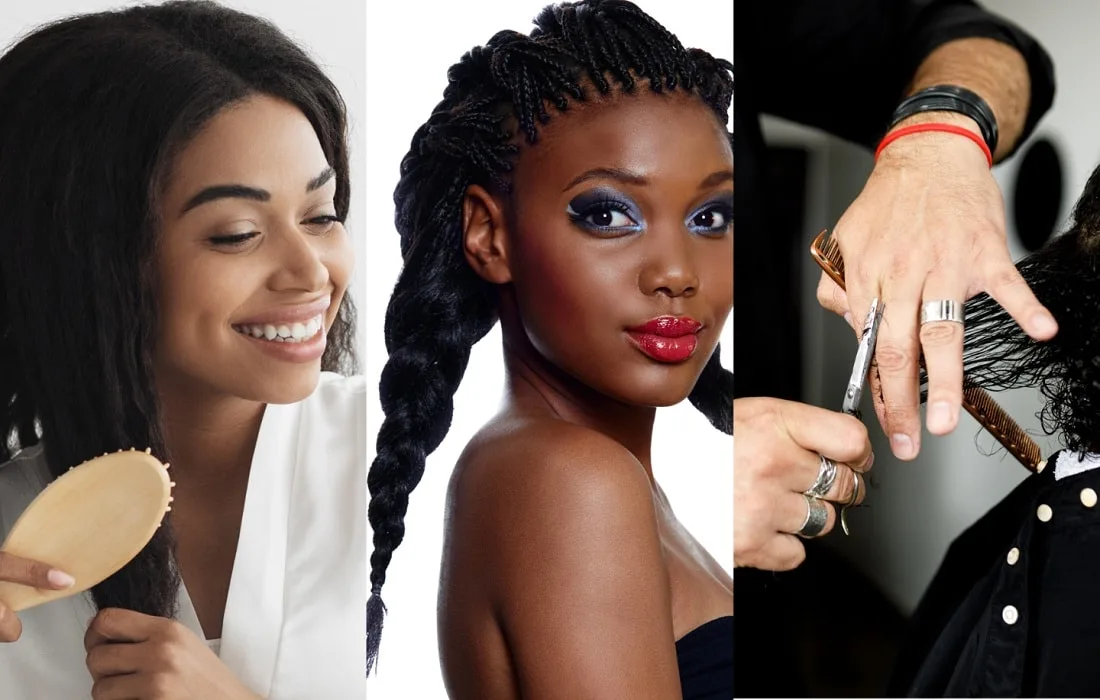If you’ve been rocking relaxed hair for some time and have decided to embrace your natural texture, you’re in the right place. Transitioning from relaxed to natural hair can feel like a daunting task, but with patience and the guidance, it’s not that tough. In this article, we’ll discuss if you can transform relaxed hair into natural hair.
Is It Possible to Transform The Relaxed Hair Into Natural Hair?
No. Relaxers are permanent treatments, so you can’t turn relaxed hair back to natural hair without cutting it.
However, you can experiment with the texture of your relaxed hair so that they look more natural. Or you can start transitioning back to natural hair with your new growth. We’ll discuss how to do both.
Go from Relaxed to Natural Hair (Fake It)
To create a natural hair look with your relaxed hair, you can try to make more texture in your hair or try hairstyles that look more ethnic. Here’s how:
Air dry

When you air-dry relaxed hair, it creates more texture. This is because the relaxer breaks the hair bonds but doesn’t fully straighten your hair (usually). So you probably have some loose 3A curls in there, somewhere. These will come out more when you air dry.
Your hair should also frizz up some, which also adds texture. To hide the differences in texture between curls and frizz, use a headband to cover your hairline, then try mousse to make extra curls.
Bantu knots

Once your hair is already air-dried, you can switch up your style if you wish. First, section it and wrap it into Bantu knots. As long as you don’t make them too sleek, no one will notice that your hair is not natural.
Don’t forget to lay your edges! Then when you’re tired of it, you can let it down into a curly style. It will still have enough texture to look natural.
Braids

You don’t always have to curl your relaxed hair or wear it straight. For example, braids can be done on straight hair or natural hair. In fact, they look neater when they’re done on straight hair.
So go ahead with this ethnic style and relax, knowing that you look like yourself again.
Transitioning from Relaxed to Natural Hair With New Hair Growth

If you’re really tired of relaxed hair, it might be time to transition back to natural hair. However, transitioning can be difficult for one reason: detangling can snap your hair right at the point where natural hair meets relaxed hair. Try these tips to avoid that and to have a successful transition in general:
- Avoid shower detangling: The biggest problem with detangling your hair while in the shower is that you don’t want to spend more time in there than necessary. So you might rush and pull on your hair more roughly with your detangling brush. Even if the conditioner is still in your hair as you detangle, and it should be, you’ll end up pulling out a lot of extra hair.
- Finger detangle: Instead of detangling in the shower, sit down before a mirror and take your time. Use your fingers instead of a wide-toothed comb or a detangling brush. This way, you can really feel where the tangles are and dislodge them gently.
- Stretch your roots: Because your roots will have a thicker texture than the rest of your hair, it’s best to keep them as straight as possible. That means stretching your roots as much as possible or keeping them stretched with Bantu knots and braids.
- Protective style: These days, protective styling refers to wigs and weaves, but it wasn’t always that way. You can also protect your hair by keeping the relaxed ends tucked into Dutch braids, Bantu knots, or a bun. This helps avoid too much breakage.
- Don’t protective style with wigs and weaves: Although they help you look nice, weaves can put too much pressure on your hair and hair follicles, causing breakage. In addition, wigs don’t allow the hair to breathe. They weaken the hair because of this, whereas you need your hair to be as strong as possible to make it through the transitioning.
- Clip your ends: This is so important! If your ends are uneven or split, it will make detangling 100% more difficult. On the other hand, if you clip your ends regularly, you’re making your hair easier to comb. You’re also slowly ridding yourself of any damage the relaxed part of your hair has suffered.
- Keep it simple: Establish a routine that works for you, such as shampoo, conditioning, moisturizing, and a protective style.
- Keep your hair moisturized: Maintain moisture for healthy hair, focusing on both natural curls and relaxed ends.
- Keep up with trims: Regularly trim ends to minimize breakage and split ends.
- Deep condition often: Provide extra TLC to the fragile line of demarcation to avoid breakage.
- Limit heat usage: Cut out direct heat to promote healthy hair growth and reveal new curl patterns.
- Patience is key: Embrace your unique hair journey without comparing it to others.
- Document your journey: Keep a visual diary to celebrate your progress and achievements.
You’ll want to transition until your natural hair is long enough to hold a style on its own and then completely cut off the relaxed ends. The time this takes varies by preference – whether you want an afro or natural hair that’s long enough to twist or put into a bun.
Honestly, though, you probably won’t make it far enough to put your natural hair into a bun without relaxed ends. The ends might be so broken by that time that it’s better for your hair’s health just to cut them. But if your hair gets anywhere near long enough, pat yourself on the back for your patience and excellent work!
Related Topics
- How to Tell If My Relaxed Hair Is Low or High Porosity
- Can I Bleach My Relaxed Hair?
- How to Protect Relaxed Hair from Breakage and Damage
- How to Dye Relaxed Hair Without Damage
- What Happens if You Stop Relaxing Your Hair?
- How to Moisturize Relaxed Hair Without Weighing It Down
